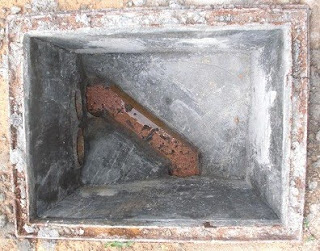Considering the house was 50 years old, the septic tank was in surprisingly good condition - another testement to the quality of materials and workmanship of the past. Even the clay underground pipes were intact. However, due to the expanded footprint of the new house design, the underground sewage pipes had to be re-routed and replaced.
Pic 1: Two of the four septic tank covers.

Pic 2: Rusted manhole cover and frame.

Pic 3: New GBH clay and Bina Plastic PE sewage pipes.

Pic 4: Newly dug out trenches for the sewage pipes.

Pic 5: Sewage pipes connected and buried.

Pic 6: New service manhole being constructed.
Pic 1: Two of the four septic tank covers.

Pic 2: Rusted manhole cover and frame.

Pic 3: New GBH clay and Bina Plastic PE sewage pipes.

Pic 4: Newly dug out trenches for the sewage pipes.

Pic 5: Sewage pipes connected and buried.

Pic 6: New service manhole being constructed.

Pic 7: South wing bathroom piping being connected to the new service manhole.
Pic 8: Close-up of sewage outlet pipes from Bina Plastic Industries Sdn. Bhd.
Pic 9: Close-up of sewage outlet pipes leading into the service manhole (partially complete.)
Pic 10: The pipe at the corner manhole was laid at a 45 degree angle instead of 90 degrees in order to ensure a smoother flow.
Pic 14: Some of the sedimentation that was found at the bottom of the tanks.
The conditions of the water tanks, however, were very bad. Both tanks showed advanced stages of rust and considerable amount of sedimentation.
Pic 11-13: This is what happens to the water tank after 50 years!
Pic 14: Some of the sedimentation that was found at the bottom of the tanks.








No comments:
Post a Comment